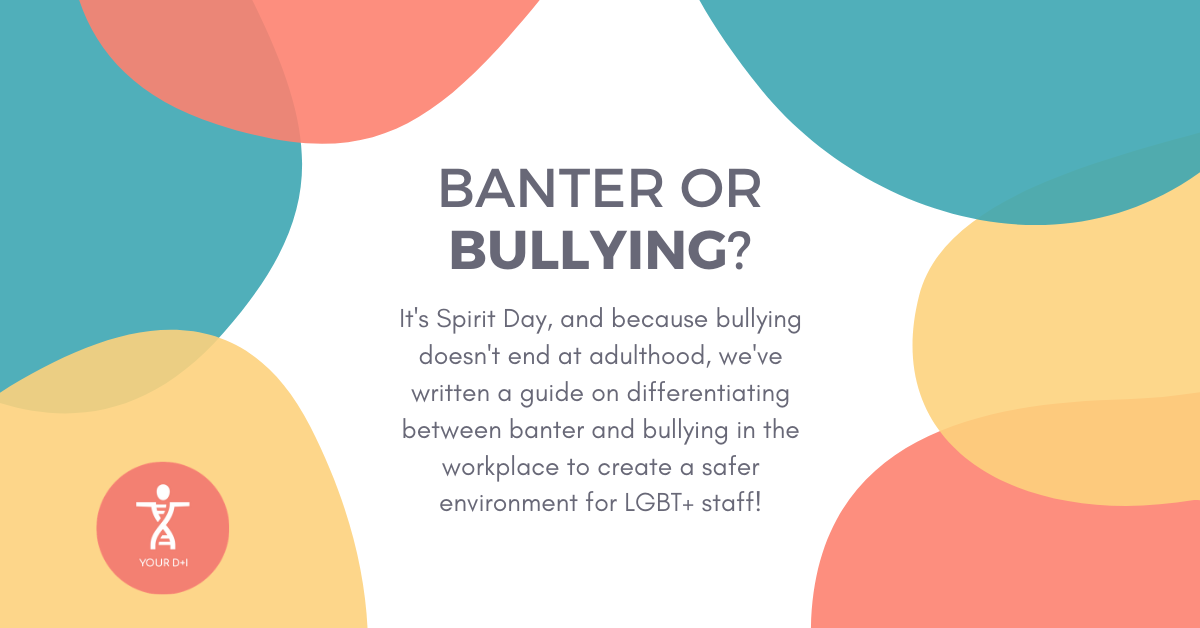Banter Or Bullying?
Today is Spirit Day, an annual event that raises awareness of the disproportion of bullying faced by LGBT+ youth. Each year, millions around the globe don purple clothes in solidarity with young people facing bullying due to their identities. This event may not seem too relevant to your company, but bullying doesn’t end at adulthood. Bullying of LGBT+ individuals could be happening in your office without you even realising it. This is because adulthood bullying often hides behind workplace banter. And it’s not always easy to tell if it’s banter or bullying.
That’s not to say that there is no healthy banter! Appropriate work banter can help productivity and create a sense of culture. However, banter should be monitored to ensure that the culture it creates is a safe one. Read on to discover how you can differentiate between banter and bullying.
What is workplace banter?
Workplace banter is a humorous conversation made between colleagues. It often involves lightly teasing other people or things in the office. As long as these jokes do not upset the people they are about or concern any protected characteristics, banter can be a healthy part of office culture that helps people bond.
In fact, short bouts of banter between periods of work can help a team focus on their tasks and keep morale high. However, a manager should ensure that banter does not begin to effect productivity and overall wellbeing. But how can you tell?
Well, banter can be categorised into three types to help with this process. Here’s a run-down of each one:
Harmless Banter
The first category is harmless banter. These are the kind of conversations that raise morale but do not interrupt productivity at work. This is usually because they take place in breaks between work, helping staff let out some energy and then focus on their tasks.
They also avoid any sensitive topics that may be upsetting to certain individuals. It can sometimes be difficult to tell if somebody is really upset by a joke made about them, but keeping an eye on their productivity may help. If they haven’t been able to continue working at their usual level, it is likely that the banter was not harmless.
Ignorant Banter
Probably the most common type of banter is ignorant banter. While these conversations and remarks are made with the same intentions as harmless banter, they can affect the wellbeing of others in the office. Ignorant banter also affects productivity as this is closely linked with the mood of employees.
An example of ignorant banter might be a male colleague making a joke about the lower performance of women in the building. He did this to get a laugh out of his peers and didn’t realise that this would cause offence.
The best way to combat ignorant banter is by educating your staff on what is and isn’t appropriate. Education and monitoring of the topics of workplace banter is incredibly important. Like we mentioned, protected characteristics (such as race, gender identity, sexuality and disability) should always be avoided when it comes to banter. Consider using workshops to keep your staff socially conscious when it comes to these topics.
Malicious Banter
The third and final type of banter is malicious banter. This occurs when someone repeatedly uses a certain target in their jokes and/or is doing so to cause hurt. This hurt could be anything from having their self-esteem reduced, feeling worried while at work or having opportunities taken away.
An example of malicious banter would be a member of staff making fun of another person’s appearance while they are giving a presentation. This could upset their colleague by making them feel self-conscious. It might also effect their chances of being taken seriously during their presentation and getting the recognition they deserve.
What can you do?
Once you have identified the type of banter going on in your workplace, you will be able to combat it. If you are aware of ignorant or malicious banter, you should speak up against it. After all, silence is just another way of giving approval. However, stopping harmful banter is not always a simple task.
To learn more about banter, including what to do when it gets out of hand, check out our workshop It’s Just Banter. What we’ve discussed today is just a taste of what you can learn in this dedicated workshop.


